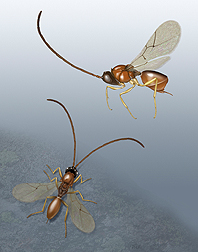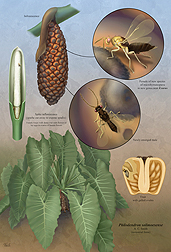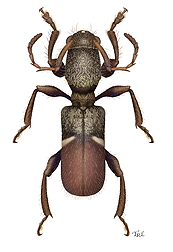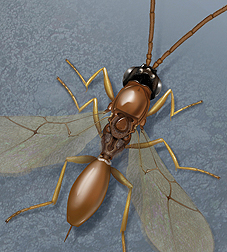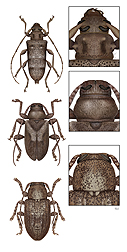Taina Litwak: Insect Illustrator Extraordinaire
|
|
Taina Litwak is a scientific illustrator for the Agricultural Research Service’s Systematic Entomology Laboratory (SEL) in Washington, D.C. Assigned to a SEL office located at the Smithsonian Institution’s National Museum of Natural History, Litwak is ARS’s “go-to” illustrator when it comes to detailed drawings and paintings of the latest insect and mite species of scientific interest—some because of the harm they could inflict to crops as invasive pests, and others for their potential to biologically control the pests.
Agricultural Research (AR) magazine recently caught up with Litwak to talk about her work as an ARS scientific illustrator.
AR: How did you get your start as an illustrator?
Litwak: I graduated from the University of Connecticut with a B.S. in Biology and a B.F.A. in printmaking in 1979. After a short period of working as a fine artist (and waitress), I realized I enjoyed the purpose and imagery of science too much to leave it. I haunted the halls of the National Museum of Natural History in Washington long enough to hear of a position opening up illustrating mosquitoes for the Walter Reed Army Institute of Research. I landed the job and stayed until 1993.
AR: When did you join the SEL, and what types of research do your illustrations support?
Litwak: I joined the staff of SEL in January 2010, but I had already done a lot of contract illustration work for the entomologists there and elsewhere after I left Walter Reed. The research my work supports is systematics. Systematists, as well as taxonomists, identify, describe, and classify organisms. This is a critically important element in understanding biodiversity, wider studies of ecosystems, environmental change over time, and change brought on by human endeavors, including the introduction of invasive species.
AR: Can you give some recent examples of the types of illustrations you have done?
Litwak: I am just starting work illustrating a new species of beetle in the same group as the citrus root weevil. It is rather large and beautiful, a recent USDA domestic interception, and a potential pest species. I did illustrations of three new species of bark beetle from the Dominican Republic for SEL entomologist Steve Lingafelter [published in the journal Zootaxa]. In 2011, I did a painting of a new species of tiny parasitic wasp in the genus Perischus. It is involved with parasitizing a species complex of flies that lay eggs in cucurbit plants, like melons, cucumbers, and the squash family.
|
|
AR: What is your process for tackling a specimen?
Litwak: The illustration process starts with a pencil drawing—or series of drawings—done through the microscope. I have both dissecting and light-transmitting microscopes in my office. Positioning the specimen correctly is important and challenging, especially if it consists of tiny dissected parts floating around in glycerin or alcohol.
Once I have drawings, I scan the sketches and work with the now-digital images to arrive at a fully accurate, ideal view of the insect. The rendering [color painting or black “ink” line drawing] is done in a fairly traditional manner, but completely digitally, using Adobe Photoshop.
AR: What’s unique about the type of information that can be conveyed with a painted illustration versus other formats, like a photograph?
Litwak: Insects seldom die with their head in just the right position and all their legs and wings spread out for a clear view. When I do an illustration, it can be a perfect, idealized view. In paintings of extremely small insects, I often include details only visible using a scanning electron microscope. Another thing an illustration can do which a photograph cannot is to condense information from several specimens into one image.
AR: How long does it generally take to complete an illustration, and how many do you estimate you’ve done in support of SEL research?
Litwak: A simple line drawing might take half an hour, a full-color individual species 3 days, and a complex plate with many images can take several weeks to complete. I have done thousands of insect illustrations over the past 30 years, and many were for SEL.
|
|
AR: What do you find particularly challenging—and rewarding—about illustrating insect and mite specimens?
Litwak: I really love the visual variety of insects, their forms and the beauty and precision of their exoskeletons. The most challenging work for me is working with very minute specimens—mites and microhymenoptera. I love what I do, because I am always learning.
AR: Where have some of your illustrations ended up?
Litwak: Most of my insect illustrations for the USDA end up in peer-reviewed scientific journals, but I have done other types of illustration projects that have landed my work in interesting places. For example, I was the illustrator and assisted with the development of several volumes of a series of science-and-technology textbooks for middle schools.
AR: Any advice for aspiring science illustrators?
Litwak: Study science! Absorb as much information about as many different things as you can. Observe things. Learn how to focus. Practice drawing what you see, not what you think you see.
"Taina Litwak: Insect Illustrator Extraordinaire" was published in the September 2014 issue of Agricultural Research magazine.







